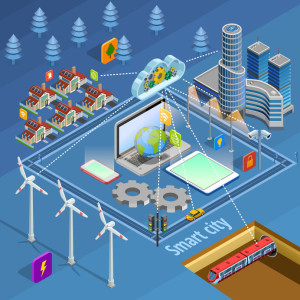Smart advances in landscape architecture
 Architecture, engineering and construction are changing rapidly due to new technologies and new challenges. Landscape architecture is changing, too. One big change that often surprises people is the adoption of “smart” digital technology into landscape architecture.
Architecture, engineering and construction are changing rapidly due to new technologies and new challenges. Landscape architecture is changing, too. One big change that often surprises people is the adoption of “smart” digital technology into landscape architecture.
You may have heard of smart appliances, smart buildings and even the smart city. As the interface between the environment and the built structures — the designed and built space between the city and the building, if you will — landscape architecture has much to benefit from smart technology.
Smart tech, smart buildings, smart environment
The idea of smart technology means using electronic hardware and software to do more than automate functions. It also allows buildings and machines to respond to changes in their environment and the demands upon them.
For example, a smart building can automatically adjust heating and cooling systems not only in response to the outdoor weather conditions, but also to the number of people inside. Why devote resources to air-condition an empty building? Why light an empty room? Smart technology helps a structure attain optimal operating efficiency with minimal human intervention.
Smart buildings also connect various systems so they can respond to each other. For example, the same sensors that determine when someone enters a room to turn on the lights, can also notify the security system that someone has entered a sensitive area, or when there is a fire threat.
Another crucial element is connection to monitoring. Smart systems automatically send alerts through the cloud or Internet to key peoples’ smart phones or other devices to warn about breakdowns, failures, or security concerns. For example, the fire system can notify building managers or owners through their smart phones or email, while also sending an alarm to the local fire department.
Where smart tech fits into landscape architecture
The purpose of landscape architecture is to integrate a structure into its environment. It’s about much more than making the outside attractive to potential customers, although that’s important.
A building has to suit the geology and geography of its space. Good landscape architecture can preserve the ecological sustainability of a building project. It can ensure structures are suited to the climate, and make them resilient to extreme events like heavy storms, blizzards and floods.
Landscape architecture can manage storm water flow and traffic flow, and can contribute to soil, water and air clean-up.
Landscape architecture also considers lighting, maintenance and security of outdoor space. Integrating smart technology will link these three systems so they communicate with, react to and support each other — for example, using motion and light sensors to turn on outdoor lights when people need them, opening or locking gates and other access points, and notifying security about unauthorized access.
Smart sensors can control lighting and signage in parking structures, adapted to traffic flow outside.
Another trend is to add rooftop or vertical gardens on buildings. They can make a big difference in the structure’s environmental sustainability, and maintaining them is a perfect job for smart technology.
Sensors can monitor the conditions of the garden, activate watering and other maintenance systems, and alert building management in advance of any problems.
Elements of smart landscape architecture
Integrating smart technology into landscape architecture depends on some key elements:
- Sensors — motion, temperature, lighting, humidity, water leakage, vibration, smoke, CO, visual, etc.
- Controllers — to activate sensors and responses, such as sprinkers, alarms, lights, HVAC, locks, doors, elevators, etc.
- Connectivity — wired and wireless networks to connect all the sensors, controllers and other devices.
- Monitoring — smart technology connects to devices through cellular networks or the Internet. This allows building systems to send alerts and reminders, and allows people to control building systems remotely, through their smart phones or other devices.
Staying smart
It’s an exciting time in civil, structural and landscape engineering. What we can build and the way we build it are evolving fast.
If you’re curious about how smart technology can take the landscape architecture of your project to the next level, contact McNeil Engineering.

